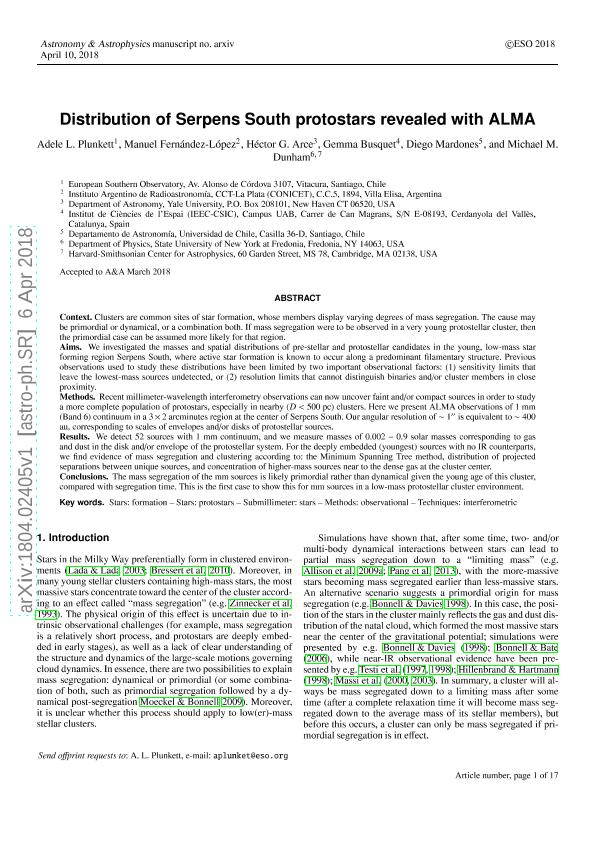Mostrar el registro sencillo del ítem
dc.contributor.author
Plunkett, Adele L.
dc.contributor.author
Fernandez Lopez, Manuel

dc.contributor.author
Arce, Héctor G.
dc.contributor.author
Busquet, Gemma
dc.contributor.author
Mardones, Diego
dc.contributor.author
Dunham, Michael M.
dc.date.available
2019-08-28T19:45:33Z
dc.date.issued
2018-07
dc.identifier.citation
Plunkett, Adele L.; Fernandez Lopez, Manuel; Arce, Héctor G.; Busquet, Gemma; Mardones, Diego; et al.; Distribution of Serpens South protostars revealed with ALMA; EDP Sciences; Astronomy and Astrophysics; 615; A9; 7-2018; 1-17
dc.identifier.issn
0004-6361
dc.identifier.uri
http://hdl.handle.net/11336/82426
dc.description.abstract
Context. Clusters are common sites of star formation, whose members display varying degrees of mass segregation. The cause may be primordial or dynamical, or a combination both. If mass segregation were to be observed in a very young protostellar cluster, then the primordial case can be assumed more likely for that region. Aims. We investigated the masses and spatial distributions of pre-stellar and protostellar candidates in the young, low-mass star forming region Serpens South, where active star formation is known to occur along a predominant filamentary structure. Previous observations used to study these distributions have been limited by two important observational factors: (1) sensitivity limits that leave the lowest-mass sources undetected or (2) resolution limits that cannot distinguish binaries and/or cluster members in close proximity. Methods. Recent millimeter-wavelength interferometry observations can now uncover faint and/or compact sources in order to study a more complete population of protostars, especially in nearby (D < 500 pc) clusters. Here we present ALMA observations of 1 mm (Band 6) continuum in a 3 × 2 arcmin region at the center of Serpens South. Our angular resolution of ∼100 is equivalent to ∼400 au, corresponding to scales of envelopes and/or disks of protostellar sources. Results. We detect 52 sources with 1 mm continuum, and we measure masses of 0.002-0.9 solar masses corresponding to gas and dust in the disk and/or envelope of the protostellar system. For the deeply embedded (youngest) sources with no IR counterparts, we find evidence of mass segregation and clustering according to: the minimum spanning tree method, distribution of projected separations between unique sources, and concentration of higher-mass sources near to the dense gas at the cluster center. Conclusions. The mass segregation of the mm sources is likely primordial rather than dynamical given the young age of this cluster, compared with segregation time. This is the first case to show this for mm sources in a low-mass protostellar cluster environment.
dc.format
application/pdf
dc.language.iso
eng
dc.publisher
EDP Sciences

dc.rights
info:eu-repo/semantics/openAccess
dc.rights.uri
https://creativecommons.org/licenses/by-nc-sa/2.5/ar/
dc.subject
Methods: Observational
dc.subject
Stars: Formation
dc.subject
Stars: Protostars
dc.subject
Submillimeter: Stars
dc.subject
Techniques: Interferometric
dc.subject.classification
Astronomía

dc.subject.classification
Ciencias Físicas

dc.subject.classification
CIENCIAS NATURALES Y EXACTAS

dc.title
Distribution of Serpens South protostars revealed with ALMA
dc.type
info:eu-repo/semantics/article
dc.type
info:ar-repo/semantics/artículo
dc.type
info:eu-repo/semantics/publishedVersion
dc.date.updated
2019-08-16T16:49:16Z
dc.journal.volume
615
dc.journal.number
A9
dc.journal.pagination
1-17
dc.journal.pais
Francia

dc.description.fil
Fil: Plunkett, Adele L.. European Southern Observatory Santiago; Chile
dc.description.fil
Fil: Fernandez Lopez, Manuel. Provincia de Buenos Aires. Gobernación. Comisión de Investigaciones Científicas. Instituto Argentino de Radioastronomía. Consejo Nacional de Investigaciones Científicas y Técnicas. Centro Científico Tecnológico Conicet - La Plata. Instituto Argentino de Radioastronomía; Argentina
dc.description.fil
Fil: Arce, Héctor G.. University of Yale; Estados Unidos
dc.description.fil
Fil: Busquet, Gemma. Instituto de Ciencias del Espacio; España. Consejo Superior de Investigaciones Científicas; España
dc.description.fil
Fil: Mardones, Diego. Universidad de Chile; Chile
dc.description.fil
Fil: Dunham, Michael M.. Harvard-Smithsonian Center for Astrophysics; Estados Unidos
dc.journal.title
Astronomy and Astrophysics

dc.relation.alternativeid
info:eu-repo/semantics/altIdentifier/doi/http://dx.doi.org/10.1051/0004-6361/201732372
dc.relation.alternativeid
info:eu-repo/semantics/altIdentifier/url/https://www.aanda.org/articles/aa/abs/2018/07/aa32372-17/aa32372-17.html
Archivos asociados
